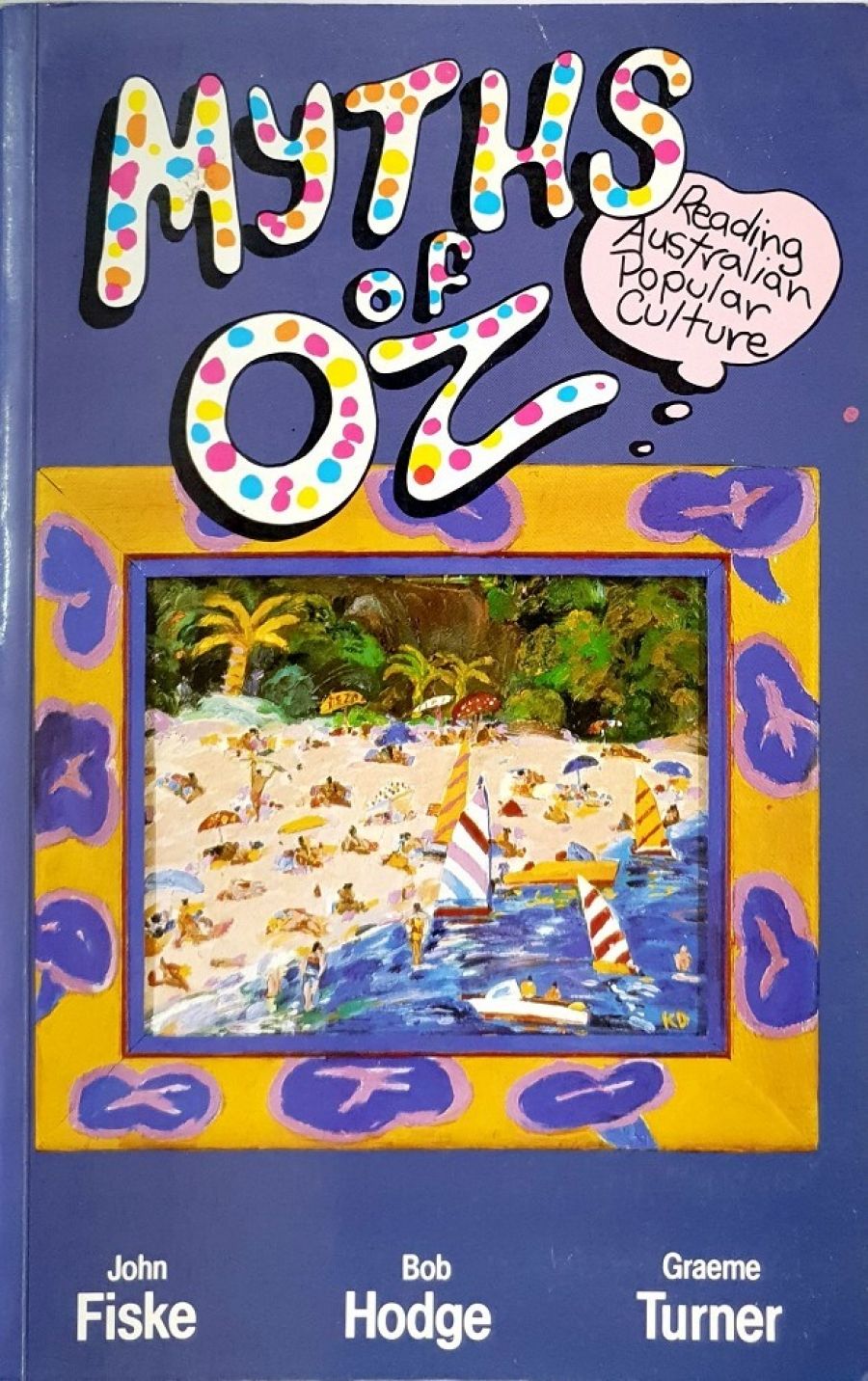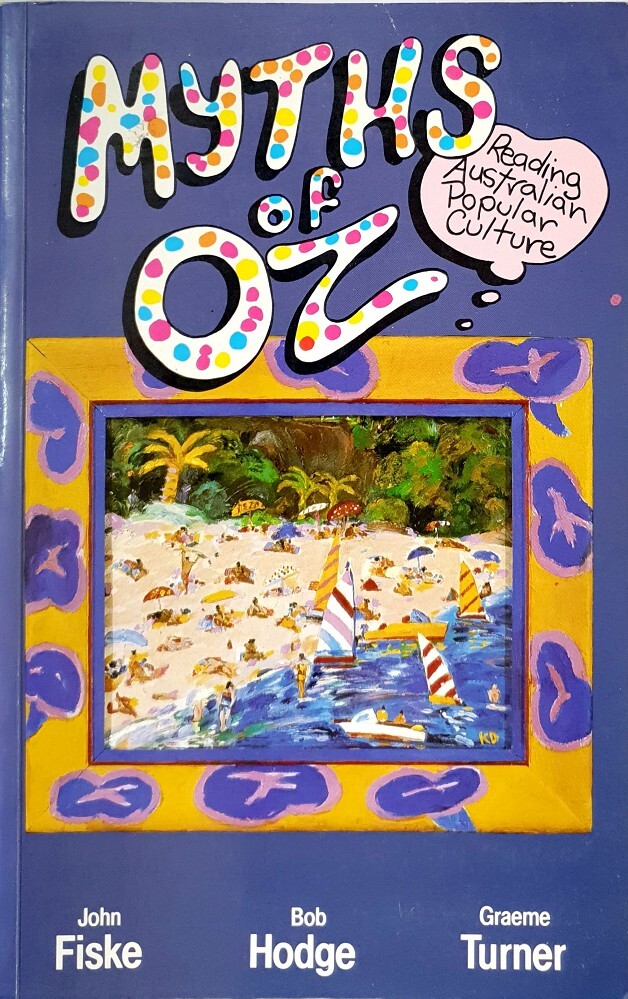
- Free Article: No
- Contents Category: Cultural Studies
- Review Article: Yes
- Article Title: Producing a culture
- Online Only: No
- Custom Highlight Text:
Myths of oz taps into the current obsession with Australian popular culture. Its success is guaranteed by its appearance at the start of Australia’s Bicentennial celebrations in which we have been invited to wallow in our national identity. As the celebrations shape up as a joke at our expense in both senses of the word, the unfolding non-event echoes a theme developed in Myths of Oz that:
- Book 1 Title: Myths of Oz. Reading Australian Popular Culture
- Book 1 Biblio: Allen & Unwin, $15.95 pb, 192 pp
- Book 1 Cover Small (400 x 600):

- Book 1 Cover (800 x 1200):

Whereas previous accounts of Australian culture have, with few exceptions argued an elitist view of Australia’s lack of (high) culture (e.g. Ward, Home, McGregor) in the pursuit of monolithic truths about Australia. Myths of Oz is concerned that the multiple forms of everyday life are of greater relevance to notions of Australian identity.
Popular culture constitutes diverse, competing and contradictory practices, self-definitions and self-delusions that defy reduction to some essentialist idea of Australianess. Consequently, any such concept is an active construction of contesting forces and claims. For Myths of Oz, the stuff of everyday life such as the pub or the beach are cultural formations that are made up of the play of factors such as class, sexual politics, domestic life, public behaviour, state regulation, etc. This attention to topics like suburbia, shopping and tourism is to be welcomed in an emergent held which has displaced the high culture priesthood in order to take other cultural forms seriously.
As the book seeks a general readership, it dispenses with footnotes and other markers of the academy. Despite this. Myths of Oz will mostly be read by those concerned with teaching, academia and cultural critique. It will undoubtedly appear on reading lists about Australian culture as the promise of the new direction.
Regretfully, Myths of Oz does not live up to its promises in some respects and the result is disappointing. Crucially, the book lacks a coherent argument that could structure its layout. Apart from a brief introduction, there is no framework in which conclusions can be located. The introduction makes the general claim that popular culture offers multiple meanings and sites of contestation within Australia as ‘lived texts’. These are supposedly systematically organised ‘around a set of connotations and meanings’ to form myths which ‘act as points of focus for the culture’ (p.xi). The book engages in ‘readings’ of ‘the different ways in which Australianness is experienced and constructed and represented’ (p.xii).
The method of analysis is ostensibly ‘semiotic’, but although Roland Barthes is sited as the source of this method, the authors misread him (if intentionally then with unfortunate consequences). But whereas their approach is random and pluralist, merely seeking multiple, changing and contradictory signifying systems. For Barthes, the process is not random but is located within a very clear argument about the transformation of post-war France into a petit-bourgeois mass culture focusing on specific characteristics of its representation as if natural and universal.
The purposeful illusion and delusion of French mythologies is tied into an extended critique of French cultural politics. Criticised though this argument has been, the point remans that Mythologies works as a book precisely because of its critical framework. It is untenable to abandon that critique and instead casually apply bits of the approach such as a crude version of the semiotic triad (sign, signifier, signified) and occasional lists of oppositions. But this is precisely what Myths of Oz offers.
It reads as discrete and chaotic observations, ranging from the banal to the insightful. At its best, it rivals dinner party critiques. Throughout it is marred by internal contradictions, inconsistent claims, and undeveloped lines of argument (especially about class, gender and consumerism). Each chapter lacks clear organisation – a typical example is the tourism chapter which briefly mentions trip statistics, camping, the Australia Card, the home, the car, the global village, tall towers, photos, Ayers Rock, Aborigines, Azaria Chamberlain and Australians abroad – with little sequential logic. Anyone of these topics would suffice to make a point; to include them all appears absurd.
As an overall project, not only docs each chapter lack a conclusion but the book as a whole is never integrated into a sustained argument. As such, the reader is deprived of a coherent guiding direction but is left with the impression that the authors have randomly dipped into bits and pieces of Australian popular culture as a pleasurable exercise but without a clear idea of what to do with the material. While the book is interesting and readable, the experience is frustrating and unfulfilling for the reader.
To some extent, the book reflects the widespread obsession with the specifics of our national identity and the competing stereotypes that circulate in that debate. ‘The problem for Bicentennial Australia is that having displaced Frank Moorehouse’s ‘proper little Australian’ raised on the A.B.C., vegemite and British heritage, no coherent replacement has been (or perhaps can be) constructed around the figures of multi-culturalism, consumerism and leisure amid the disintegration of our traditional economic base.
Thus Myths of Oz oscillates between displacing Swan lager-type images of egalitarianism, the underdog and persistence (p.xi), and either reviving similar versions or producing a fragmented, scattergun set of observations. And despite attempting to displace the colonial legacy, the pub chapter is typical in cone hiding with an English rock musician’s comments on Australian pubs: for the authors, the empire is never far away.
The pub chapter epitomises the uncertainty of the book’s trajectory. It jumps from Australia’s widely perceived alcohol problem straight to the loan of the pub as a social space, without recognising that in Australia, non-pub drinking is predominant and no significant ‘pub culture’ exists. (Indeed the photos accompanying the chapters demonstrate this with just a couple of old timers inhabiting these dens of iniquity).
In their account, pasts and the present are idiosyncratically jumbled such that quite changed relations of popularity, social nexus (e.g. in pioneering male communities), class (workers cf. professionals’ working lunches cf. the unemployed), and gender (no women cf. ladies (sic) lounges cf. meat markets’ render current pubs quite different and variable cultural forms. Continual reference is made to the ‘classical’ model of the tiled, utilitarian pub against which other types – mainly the (unique and now no more) Birdwatchers Barat Sutlers Paradise and rock music pubs – are counterposed. The lack of an historical framework and a recognition of types of pubs and their changing activities and social locations robs the chapter of a definitive argument. Australian pubs form a complex array of social arrangements (yuppie riverside pubs, miners’ pubs, suburban barns, sports club bars, restaurants and wine bars, etc): there is no point in seeking a unitary account especially when most alcohol consumption in Australia occurs outside the pub.
Sloppy inconsistencies can be found everywhere, for example, in reference to the Sydney Opera House (which is unproblematically defined as a monument). We are told that it is ‘unequivocally a success’ despite subsequent textual references to its controversial history, reception and failure to fulfil its main function (to stage opera). No mention is made of Peter Hall’s cogent argument that it is one of the great planning disasters of the modern world. We are told that its lack of functionality is precisely what is valued ‘as an expression of egalitarian scepticism towards ... high culture’ (p. 156), but then that it signifies ‘the new, confident, cosmopolitan Australia’ (p. 159). By p. 162, it is the modernity, individualist vision and abstraction of the Opera House that is significant because of its ‘very’ otherness from dominant ideologies’. Such inconsistencies, as well as errors (e.g. that the Danish architect Utzon was a Swede whose brief sojourn in Australia qualified him as a ‘distinctive Australian type reborn’ (p. 156), undermine what should have been a strong and fascinating analysis.
These examples typify the failure of the Myths of Oz project and compound the lack of integration. The authors’ decision to dispense with academic markers for this study could only work if a consistent framework of social history was employed, a sophisticated understanding of semiotic analysis (cf. the work of Anne Freadman) or pithy and incisive observations on more systematically chosen topics undertaken.
As it is. Myths of Oz looms as a Clayton’s collection, not quite one thing or another. Indeed, rather than exposing myths of Australia, these observations could aptly be re-titled The Aussie Book of Adjectives.


Comments powered by CComment